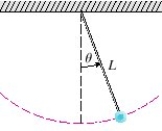The figure shows a pendulum with length L and the angle from the vertical to the pendulum. It can be shown that , as a function of time, satisfies the nonlinear differential equation where we can use the linear approximation 
A)
B)
C)
D)
E)
Correct Answer:
Verified
Q14: Use power series to solve the
Q15: A spring with a 3-kg mass
Q16: The solution of the initial-value problem
Q17: A series circuit consists of a
Q18: A spring with a mass of 2
Q20: Use power series to solve the
Q21: Solve the differential equation using the
Q22: Solve the differential equation using the
Q23: Solve the differential equation using the
Q24: Solve the differential equation using the
Unlock this Answer For Free Now!
View this answer and more for free by performing one of the following actions

Scan the QR code to install the App and get 2 free unlocks

Unlock quizzes for free by uploading documents